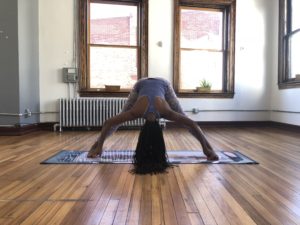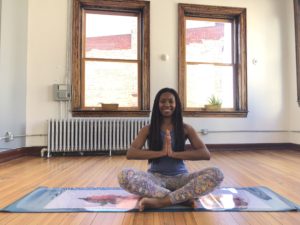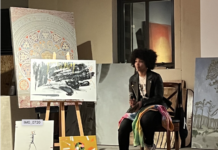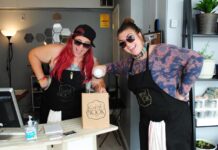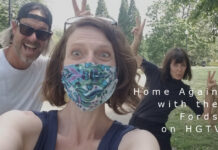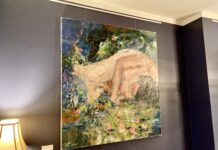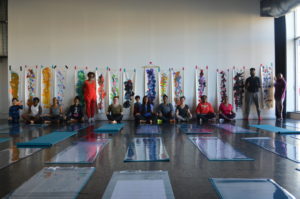 YOGAMOTIF is breaking new ground in the ‘Burgh. With innovative classes like “Astrology Yoga,” an all-levels, Hatha style class focused on areas of the body ruled by specific astrological signs; and “Delicious Wombalicious,” a gentle practice geared towards activating muscles and healing energy around the pelvis; the studio, which had its grand opening on March 24, is a true healing arts center. YOGAMOTIF also offers private parties for birthdays, bridal showers, and bachelorette parties. Most YOGAMOTIF teachers are certified through YogaRoots on Location, an antiracism professional development and yoga teacher certification program created and operated by Felicia Lane Savage. I spoke with YOGAMOTIF studio owner Alecia Dawn about her background, the YogaRoots on Location program, and her studio’s signature “make and take wellness” service, the “Yoga Paint Party.”
YOGAMOTIF is breaking new ground in the ‘Burgh. With innovative classes like “Astrology Yoga,” an all-levels, Hatha style class focused on areas of the body ruled by specific astrological signs; and “Delicious Wombalicious,” a gentle practice geared towards activating muscles and healing energy around the pelvis; the studio, which had its grand opening on March 24, is a true healing arts center. YOGAMOTIF also offers private parties for birthdays, bridal showers, and bachelorette parties. Most YOGAMOTIF teachers are certified through YogaRoots on Location, an antiracism professional development and yoga teacher certification program created and operated by Felicia Lane Savage. I spoke with YOGAMOTIF studio owner Alecia Dawn about her background, the YogaRoots on Location program, and her studio’s signature “make and take wellness” service, the “Yoga Paint Party.”
Ashlee Green: The classes offered at your studio are not the Pittsburgh norm. Could you talk more about them, particularly “Astrology Yoga” and “Delicious Wombalicious”?
Alecia Dawn: My father is an astrologer. The astrology yoga class came out of a conversation we were having about the different body parts that certain signs may find have more energy, stress, or attention. We just did Aries, which is the head. We did a lot of things that stimulated blood flow to the head for someone who is an Aries sign. We focus on different body parts each month. That’s Astrology Yoga: It is awesome. All of our Hatha Yoga classes are ten dollars, so you can come to Astrology Yoga or any of the Hatha Yoga classes and some of our classes are free.
Delicious Wombalicious: This was Sheba Gittens’ idea. This class is amazing. It hasn’t happened in this space yet, but it is with Sheba Gittens and Carrie McCann. It is a class that celebrates the womb. If you have a womb or if you had a womb, no matter how you identify, you are encouraged to come into this space for a healing experience. I was revisited by an interest in this class after I went to a conference called “Let’s Talk About Sex.” I was in a class and one of the speakers mentioned––something I already knew––but about black women experiencing more fibroids around their womb, more than any other group, and other reproductive challenges that certain ethnic groups experience more than others.
There’s twerking. Instead of doing a regular warm-up where you might do a vinyasa sun salutation a few times, we really want to make sure we energize that room with a twerk-up: Instead of a warm-up it’s called a twerk-up. So much fun. We did a class at the University of Pittsburgh with their women engineering students; it was amazing. Depending on the class, you will make wombalicious teas; they are made and curated by Carrie McCann. She specializes in making different tea combinations that are healing for a reproductive space. There are opportunities to make waist beads, which rest around the waist. The entire class––all of the moves and the poses that will be cued––are to release stress and energy and activate the muscles around the womb, the hips, thighs, lower back. pelvis, all that good stuff. We’re doing this class with and without Yoga Paint Party. It’s a smoothie of healthy wellness fun.
AG: You started your career in arts education and the nonprofit management world. What brought you to yoga?
AD: Yoga found me. I’ve actually practiced yoga for a long time; I first tried it in high school and I really stepped up my practice in college and have been doing it ever since, especially during times whenever I’ve had some––when I’ve been in transition in between college and a job or something like that. I found yoga to be extremely beneficial not only to my mental health but really being able to have a physical workout. I practiced off and on for many years. I was practicing at the YMCA on the North Side with a woman who still works there named Myrna. Her class was the first time that I realized that yoga could be truly accessible to me because her poses were not perfect and she laughed––she cracked jokes during the class, and she led the class in a way that I had never experienced. It was really informal. Her classes were always full; people were at the door waiting for the class to begin. It was that moment that really began to deepen my practice and I began to practice more regularly. I continued to go to classes with other teachers but I was able to find that sense of, ‘How does yoga work for me?’ in those classes moving forward because I was able to see it with her first.
AG: What made you want to be a teacher and open your own studio?
AD: I didn’t actually have an intention, initially, to be a yoga teacher or to open a yoga studio. I think I was just following my path. I am friends with and mentored by and all these other things by Felicia Savage Friedman––her new married name––and she mentioned that she was doing a yoga teacher training with, as you are aware, her yoga studio––her yoga company––YogaRoots On Location. I had always wanted to pursue a yoga teacher certification but for probably more shallow reasons; I wanted to be strong and be flexible… which is fine, that’s cool, but there are other things to do. When she mentioned that she had a training, I just said, ‘Why not?’ and I just took a leap of faith and spent a year in her training. I came out the other side of that with a different understanding of myself. One of the things about her training is really looking at yourself and recognizing that you have to be on a path of healing before you can make a healing space for other people. That’s pretty much what that year was about for me; What places did I need to address so that if I’m in a room… I’m not the stressed-out yoga teacher. How am I going to create that relaxing space for others if I’m thinking about the dinner that I need to cook in five minutes or whatever––if I’m not able to manage my own stress?
Around the time that the training ended, I also left my full-time job in nonprofit management––mostly due to life change: I had a young child and I just needed to change how I spent my days. I took a moment to figure out what I was going to do next and I thought about this yoga painting idea that I had for a few years. I never put a lot of thought into it. I did some Googling. I thought about it enough and I said, ‘You know what? You keep thinking about this idea.’ One of the things about this training is that you need to pay attention to these little stirrings that you have in yourself that are guiding you to where you’re supposed to be.
 Yoga painting seemed really silly to me initially, but I thought, ‘You know what? You keep thinking about it, so you might as well just do it. Do it full out and you’ll figure out if it was a good idea or not.’
Yoga painting seemed really silly to me initially, but I thought, ‘You know what? You keep thinking about it, so you might as well just do it. Do it full out and you’ll figure out if it was a good idea or not.’
I got some materials together and had a little studio in my house and designed and created the YOGAMOTIF mat. I got a provisional patent for this mat and YOGAMOTIF grew from there. It was really a need to initially––lots of different needs. One was… in addition to creating healing spaces for myself, before I step into a yoga studio, how do I create healing spaces for other people?
I realized that I could go anywhere far and wide to create those spaces. This yoga painting idea reminded me of the feelings that I had from that yoga class with Myrna, which were: yoga can be informal, yoga can be fun, you don’t have to have the perfect pose to participate.
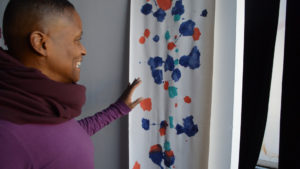 It was the merging of a lot of those ideas of: You have this idea that you’ve been thinking about for a while, you should do it, and also, how do you create a healing space for somebody that allows them to let their guard down and step into a practice for the very first time that might provide a healing pause for them, or not only begin someone’s practice but deepen someone else’s practice with the opportunity to really see what yoga looks like in a 2-D form, in paint.
It was the merging of a lot of those ideas of: You have this idea that you’ve been thinking about for a while, you should do it, and also, how do you create a healing space for somebody that allows them to let their guard down and step into a practice for the very first time that might provide a healing pause for them, or not only begin someone’s practice but deepen someone else’s practice with the opportunity to really see what yoga looks like in a 2-D form, in paint.
AG: You and most of the YOGAMOTIF teachers were certified through YogaRoots on Location, an antiracism professional development and yoga training led by Felicia Lane Savage. Can you talk more about this training and what sets it apart from other yoga teacher certification programs?
AD: Just to be clear, I’ve done very little research on other yoga teacher trainings to compare, but I can share about what makes it special for me and what people have mentioned to me when they were researching other places.
The yoga teacher training is an anti-racism and trauma-informed training. It really teaches you how to create a healing space for yoga without causing harm to people, or re-traumatizing people, or triggering them to experience some pain that they may have experienced in other places.
How that manifests with me is thinking about the language I use in a space––Maybe I don’t touch people, I don’t provide assists in a class. For someone, that might be triggering if they have experienced a physical assault in some way or they’ve had surgery or maybe their body is different that day and if I go over to touch them, that may no longer be a healing space for them.
One of the things that makes it particularly special is it’s more like a Raja yoga teacher training, so that focuses on the eight limbs of yoga and the majority of the class is about that personal development and really thinking about how are you embodying these practices in your life and in your person while you are teaching. Are you for example not stealing, not taking things from people? And that’s really obvious: Don’t take anybody’s wallet. That’s one way. But also, are you taking someone’s time? Are you taking from someone’s experience because of your own interests of centering yourself in the conversation whenever you might be the one to listen? That’s a very subtle thing, but think about a time whenever you had a moment that you wanted to share something important and they took an opportunity to listen to you instead of centering on themselves and what they think about your decisions or life experience. The training really focused on thinking about your personal practice of yoga and also how that communicates into the physical practice when you are in a leadership position in a learning space.
And also, this idea of antiracist organizing and undoing racism and weaving that into the practice as well. It was a really beautiful space because the space was filled with people of all backgrounds: black people, white people, brown people. I’m clearly not able to identify every single person in the space, but people of diverse backgrounds and being able to have honest conversations about race and how that can come into a yoga space. How people may be dealing with trauma as a result of experiencing racism––upholding racism in their life and their daily practice and how can you as a yoga teacher not re-traumatize someone because of that.
It’s a year-long program, so it’s a very long conversation, but how that really unravels is having yoga teachers who are not perfect, but are recognizing what they might be doing––what they might do differently to make a more healing space in a yoga studio or beyond.
Our teacher calls herself our “gentle yoga guide.” She had confidence in our abilities to have our asanas down pat and being able to go through the sequences. She has mentioned––my words––’You’re gonna get there.’ What you may not find at other places is this personal development.
For example, most of my training was done in places where people had limited mobility. How do you teach a yoga class to someone who can’t stand? We are not encouraged at all to write our classes down ever because you write a class down and then you have someone in the space who may have an obvious injury, or maybe they tell you, ‘I cannot do this today,’ so all of a sudden you may be teaching a class that the people in the class can’t actually participate in. We are encouraged to teach to the people in the room and to be very responsive to how people’s bodies are moving.
You could say, “OK, this person looks really dizzy. We’re not going to do that balancing pose anymore. We’re all going to the ground because I want to keep everybody safe.” That’s a type of trauma-informed yoga practice. Because this person might try to push them self. Maybe they want to push them self––that’s fine––but do that at home so that you can be safe. That’s the difference.
I really enjoy a vinyasa class, a power yoga class. I’m all down for all of that. It’s a great time, a very juicy experience for me. However, I notice that there are spaces where that is intimidating and to get to that power vinyasa flow, a practice that is trauma-informed might be the first step into healthy living.
AG: YOGAMOTIF’s signature service is the “Yoga Paint Party.” Can you explain what this is?
AD: Our flagship class, “Yoga Paint Party” is an opportunity to experience finger painting on steroids. You use your body as a paintbrush to create an original painting using your yoga flow. We do this on top of the patent-pending yoga mats. Folks will put a canvas down, they’ll put their own design in paint on top, and then they’ll put another layer of a clear vinyl that will allow them to see their paint underneath. As they move upon the mat and the weight of their body moves around on the mat, the paint moves and you create a yoga snapshot of your experience. They’re about two to three hours long, depending on the activity.
We’re in our workshopping phases: We’re doing some yoga painting, but we are excited to explore different things to paint on that people might be able to take with them. We’re excited to work with different artists to lead workshops, on top of the paintings.
We have an “Artist Kickback” series that features different interdisciplinary artists doing workshops with them. It’s a really informal environment to play with paint and to celebrate your body and to receive all bodies into the space. We encourage people, if they don’t want to participate, or are feeling like their body is talking to them in a different way, telling them to be in child’s pose, for example, the entire class, we encourage them to do that. We encourage them to play and to move meditatively on the mat, maybe moving the paint around with their fingers and toes and just having fun. Afterward, folks leave with a scroll painting that they can hang in their home of: “This is yoga for me. This is my yoga right here.” It’s a lot of fun.
Check out the studio website for more information and to fill out a Yoga Paint Party Request Form. Reach Alecia at alecia@yogamotif.com.




